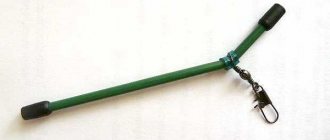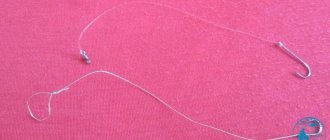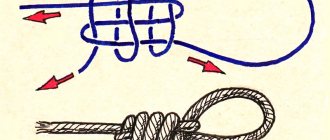Purpose of the tool
The main purpose of the product is to check how strong the ice is, how thick it is, and whether it can withstand the weight of the fisherman. With the tip of the device, the fisherman hits the ice in front of him, assessing the result of his actions. It is customary to go on the ice when it can withstand a couple of blows from an ice pick without breaking through. Otherwise, there is a high probability of finding yourself under the ice.
The second purpose of the device is to make holes. With ice thickness of 7–15 centimeters and constant movements during fishing (for example, when searching for perch), the ice pick does its job perfectly.
Why it is not recommended to buy an ice pick in a store
We’ll talk about the advantages of the shapes of the pick tip a little lower, but now let’s focus on the handle. The matter of choosing a handle is not as simple as it seems at first glance.
What should the handle of the pick be like?
- When grasping the handle, the hand in the mitten should close completely.
- The thickness of the handle must ensure rigidity of holding, and therefore the handle should not be made of a constant diameter along the entire length, like a shovel.
In this case, when working, your hands get tired faster, being constantly in a tense state.
- Never sand the surface of the pick handle with fine sandpaper. Let it be rough and “ugly”, but a slight roughness makes it easier to hold.
- The height is selected according to the height of the fisherman. The minimum is shoulder level; in fact, when punching a hole, your back should be straight. In this case, the blows will be delivered more strongly and there will be less stress on the back. The total length of the pick will be small:
- Your back gets tired when punching holes.
- It becomes more difficult to use if you need to check the thickness of the ice when moving through dangerous places.
- In the case of “bathing” there is no possibility to use it as a pole.
- I can tell you from experience that the presence of a grip on the upper part of the handle makes it easier to use, because it serves as an additional stopper for the brush and somewhat balances the handle.
- A safety loop is required.
These are exactly the points that store-bought products often do not take into account.
Components of an ice pick
Any winter ice pick contains a wooden handle (handle) and a metal tip, which is used to chop ice. The tip has a hardened working tip 20–30 cm long of various shapes, and a non-working part that does not require hardening and is connected to a cone-shaped or cylindrical “glass” into which the handle is inserted.
We also recommend reading:
How to properly tie a jig to a fishing line Winter fishing for gudgeon with a jig How to catch taimen in winter Winter skating: features of equipment and fishing techniques
Design features
The fishing pick is made of metal and has a triangular, flat or tetrahedral tip, mounted on a durable wooden base. The end of the base is equipped with a thickening, under which there is a hole for threading a rope. The rope is attached to the belt. This prevents the instrument from slipping out of your hands and going under the ice. Most fishermen choose an ice pick with a triangular tip for its ease of penetration into the ice cover. Moreover, each edge has a certain sharpening. The lance must be well sharpened.
Gallery: winter ice pick (25 photos)
Making a mini pick for cleaning holes
Frosty weather also brings unpleasant surprises in the form of frozen tackle and holes, which can be easily dealt with with a mini-pick connected to a slotted spoon.
This tool is not for sale, which only means making it yourself, for which you will need:
- slotted spoon. Some fishermen make it themselves, for which they use thin stainless steel in which holes are drilled;
— a fragment of a pipe (squeeze), the diameter of which is about 22 mm;
In addition, you will also have to use an emery machine, a grinder, an electric drill, and a welding machine.
Step-by-step tool manufacturing:
- First the point is made. A trapezoidal blank is cut from a piece of spring using a grinder.
- The pipe is shortened to 100 mm, after which the burrs are removed and chamfered. The workpiece is mounted and welded into the slide, then it is sharpened using emery and given the desired shape.
- Next, you need to shorten the handle of the scoop, otherwise after production the product will be too bulky, as a result of which it will be extremely inconvenient to transport it. Using a knife with sandpaper, the thickness of the handle is adjusted to the inner diameter of the pipe. When this is done and the handle goes inside with force, you need to drill a through hole in it.
- It is recommended to clean the metal tip, then degrease it and paint it. After drying, it is put on the handle and secured with a bolt and nut.
- The undoubted advantage of such a tool is that the tip can be easily dismantled and what remains is an ordinary fishing scoop.
Video tutorial
Types of fishing tips
According to the shape of their tips, ice picks are of two types:
- in the shape of a wedge with edges converging at one point
- chisel-shaped with one or more parallel edges
Wedge-shaped points come in the following shapes:
- triangular pike or "spear"
- tetrahedral peaks
Chisel points can take the form:
- bits
- shoulder blades
- other forms
Handmade ice pick
This device, of course, can be purchased at the store. Copies for every taste are sold. But, you can make an ice pick yourself. During production, various tools and parts are used, sometimes even the most improbable ones, such as the spring of a Moskvich car, the cardan of a T-40AM tractor or a torsion from Zaporozhets. Indeed, the most incredible preparations are used.
Large forged picks used for chopping ice are in great demand.
Pick hammer
There are a huge number of handmade products. For example, consider the following example, made independently.
A jackhammer is used for production. The tip is made in the form of a sting. The thickened part is sawed off from the bumper, and the tip is welded to a pipe having the required diameter. The pipe is placed on a wooden part. It is best to use maple, elm, oak, and birch to make the wooden part. Now you need to sharpen the blade well. The sharpening can be three- or four-sided, in the form of a chisel or lance.
Ice pick using a bolt
We offer another version of the pick. A slot is made in the head of the M20 bolt into which part of the spring leaf is attached. The sheet is welded. Two M20 nuts are screwed onto the bolt, which are also connected by welding. You need a piece of pipe up to 1 meter long and 45 - 57 mm in diameter. Nuts are welded to a section of pipe. The tip is sharpened on one side. At the top of the pipe there are holes for the handle. A hole is drilled in the handle for the rope. The length of the handle is at your discretion.
Ice pick from a file
To make the tip, you can take a file. Weld the tip with the pipe. A chisel connected by welding to a pipe works well as a tip.
You can secure the pipe to a wooden base using a plumbing coupling. The coupling is threaded inside. You will need two couplings and a nipple. The idea is as follows: one coupling is screwed onto a wooden handle, the other is secured to an iron pipe with a tip. Then everything is assembled using a nipple. The wooden base must be well planted and treated. It is best to apply a paint coating to the handle.
Features of the use of picks with different tip shapes
- Wedge-shaped points produce holes that always taper downward. Chisel-shaped ones allow you to make holes in the ice with vertical walls with an expansion at the bottom.
- In the cold Russian winters, three- and four-edged “peaks” break dry ice well, and the “three-edged” one gives more accurate holes. The best performance when cutting ice is at the tip of the “spear”, obtained from a “three-edge” with deep grooves on the edges. The tips of the “tetrahedral” ones are least likely to break.
- The “chisel” point on ice picks is mainly used in commercial fishing with traps. The “chisel” perfectly breaks off large ice blocks from the edges of the holes, which turn out to be wide with smooth walls.
- The “spatula” point is shaped like a chisel, but with a sharpening angle similar to that of a “chisel”. With such a tip, ice is cut to a shallow depth, but smooth edges are formed at the hole. For loose and damp (spring) ice, a “shovel” is the best option.
Homemade pick for forming holes
The handle is a significant part of the pick. It is recommended to use birch to make the handle. It is believed that the recoil when breaking through ice is not so noticeable.
Important! Do not plan the handle with a knife, but only sharpen it.
But many fishermen also speak positively about oak and beech.
The upper part of the handle should be made wider so that it is comfortable to hold in your hands. The extension eliminates the risk of drowning the tool, and also provides a good rest for the hand while cutting a hole (you can lean on it).
- Inside the “glass” the handle should be tightly connected to the metal rod.
- Be sure to drill a hole in the handle and thread a rope loop.
- The handle can have different shapes. The choice will depend on how comfortable the hold is.
Metal rod - it is preferable to make the cutting part from steel (R18, HVG, R6M5). The part will undergo hardening, forging, sharpening, and can also be connected to the tip by welding.
The “glass” will be welded to the rod and is the fastening of the handle.
To avoid filling the “glass” with water, it is necessary that the handle fits tightly into it and reaches the end.
Shapes of sharpening
An important stage of work in the production of pickles. Over time, fishermen invented various forms of the cutting part of the ice pick.
The most common ones in use are “chisel” and “chisel”.
There are two types of sharpening:
- Drums.
- Impact pick with cutting part.
"Pika"
The shape of the rod resembles a cone. Experienced fishermen make changes to the shape by trimming the tip, the edges are gradually brought to the maximum narrowing. This helps increase the piercing effect and reduce ice crushing.
Suitable for medium thickness ice.
"Saber"
An ice pick with such a metal rod is suitable for strong fishermen. Thanks to the design features of the shape, it is possible to break off large pieces of ice. The hole comes out wide enough.
These two representatives belong to the shock type.
"Chisel" and "Chisel"
They are a piercing-cutting type of ice pick.
This shape allows you to break through thin and medium-thick ice.
The “chisel” is convenient when fishing for carp and pike. It can quickly expand and level the hole. Also get rid of the formed jumper.
"Spatula"
Refers to a piercing and cutting instrument.
The configuration of the pick allows for a neat round hole with fairly smooth edges. Good to use on thin ice.
There are options “Petal”, “Dovetail”. They overcome ice crust very well, but are difficult to produce and sharpen.
Purpose and parameters of the tool
To choose the model that suits you, you need to try out different versions of the pick. This will help you make a choice, and only after that you can start making your own pick.
When you need it, you will always have a reliable tool. With the help of an ice pick, it will be possible to make a hole of the required shape and size, test the strength of the ice cover, and, if necessary, provide assistance to a failed fisherman.
The parameters of the pick will be varied.
This depends on several factors:
- Physical qualities of a fisherman.
- Type of fish.
- Ice thickness.
- Reservoir.
The weight of the pick depends on the thickness and length of the metal rod. According to statistics, it is convenient to work with a tool no longer than 1.7 meters.
Manufacturing technology
The most difficult part in the production of tackle is making a high-quality sharpening of the metal rod.
The overall process is as follows:
- Using sandpaper, a metal stake - the cutting part, give the required shape. Perform initial sharpening. The final sharpening is carried out with a special whetstone.
- Using welding, connect the “glass” to a metal rod. Drill an additional hole for the screw to connect the handle to the main part.
- The handle is made taking into account the height of the fisherman. The diameter should be comfortable for your hand to grasp. Make a hole for the safety rope.
What is an ice pick, its purpose
A fishing tool such as an ice pick is used to break ice. The main components of the described product are a wooden handle and a sharp metal tip. Until ice drills appeared, the pick was considered the fisherman’s main tool; with its help, they not only made holes, but also tested the strength of the first ice.
Photo 1. The ice pick is indispensable on the first ice.
The main areas of use of the device in question are:
- determining the thickness of the ice cover;
- punching frozen holes made with an ice drill;
- cleaning holes from accumulated ice (during fishing with girders);
- widening the hole when fishing for large fish.











